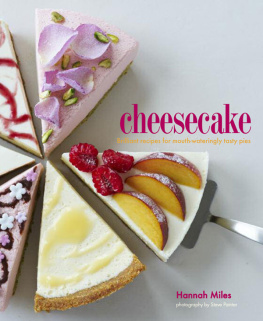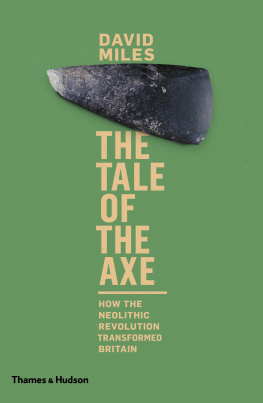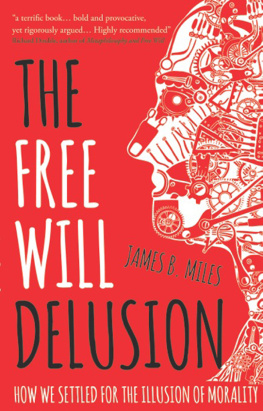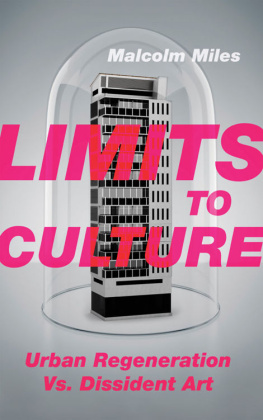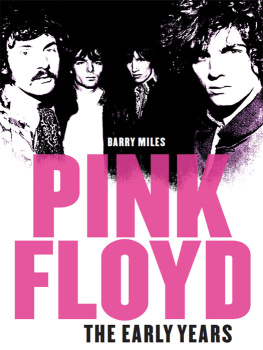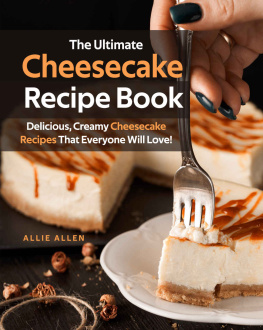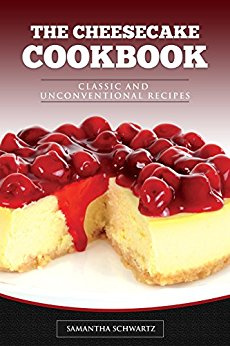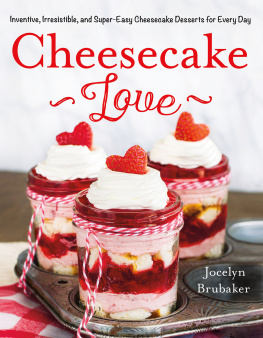cheesecake

cheesecake
classic and original recipes for heavenly desserts

Hannah Miles
photography by Steve Painter

To Gregg Wallace and John Torode, Masterchef Judges extraordinaire and lovers of a good buttery biscuit base!
DESIGN, PHOTOGRAPHY AND PROP STYLING Steve Painter
EDITOR Rebecca Woods
HEAD OF PRODUCTION Patricia Harrington
ART DIRECTOR Leslie Harrington
EDITORIAL DIRECTOR Julia Charles
FOOD STYLIST Lucy McKelvie
FOOD STYLISTS ASSISTANT Ellie Jarvis
ILLUSTRATIONS Tinckelly Illustration
INDEXER Hilary Bird
First published in 2013 by
Ryland Peters & Small
2021 Jockeys Fields
London WC1R 4BW
and
519 Broadway, 5th Floor
New York, NY 10012
www.rylandpeters.com
10 9 8 7 6 5 4 3 2 1
Text Hannah Miles 2013
Design, illustrations and photographs Ryland Peters & Small 2013
Printed in China
The authors moral rights have been asserted. All rights reserved. No part of this publication may be reproduced, stored in a retrieval system or transmitted in any form or by any means, electronic, mechanical, photocopying or otherwise, without the prior permission of the publisher.
EISBN: 978-1-84975-679-2
ISBN: 978-1-84975-352-4
A CIP record for this book is available from the British Library.
US Library of Congress CIP data has been applied for.
NOTES
All spoon measurements are level unless otherwise specified.
All eggs are large (UK) or extra large (US), unless otherwise specified. Uncooked or partially cooked eggs should not be served to the very old, frail, young children, pregnant women or those with compromised immune systems.
When using cling film/plastic wrap in the oven, make sure you use a brand which is heatproof and suitable for this purpose.
Ovens should be preheated to the specified temperatures. We recommend using an oven thermometer. If using a fan-assisted oven, adjust temperatures according to the manufacturers instructions.
Cheesecake, ksekuchen, tarta de queso, gteau au fromage however you know this delicious dessert, one thing is certain, the humble cheesecake has universal appeal. Almost every country in the world has its own cheesecake tradition and they are one of the worlds oldest desserts, with records dating cheesecakes back even as far as 200 BC. Quite frankly, I dont know anyone who doesnt love a slice of a good cheesecake! This book contains a wide variety of flavours and styles of cheesecake with something for every taste. For those who like rich indulgent cheesecakes, why not try the Rocky Road Cheesecake on for the Hibiscus, Raspberry and Pomegranate Cheesecake decorated spectacularly with hibiscus flowers and caramel sugar swirls. Whatever your favourite flavour, there is a delicious cheesecake recipe in this book for you.
TYPES OF CHEESECAKE
There are three main types of cheesecake. The classic cheesecake is a baked cheesecake, baked at a low temperature in the oven and set with eggs. The resulting dessert is rich and dense and you need only serve small slices for each portion. The popular New York Cheesecake (now eaten all over the world), such as the recipe on is the perfect example of a baked cheesecake.
Gelatine cheesecakes are the second type of cheesecake and are very different from baked cheesecakes they are light and airy and dont require any cooking. People can often be intimidated by gelatine but these concerns are misplaced as it is really very easy to use. Using gelatine combined with cream cheese and cream gives a delicate cheesecake with a creamy consistency, without being overly heavy making it possible to eat a much larger portion! My favourite recipe in this book the Plum Crumble Cheesecake on is a gelatine cheesecake and I could eat slice after slice!
The third type of cheesecake a refrigerator cheesecake is by far the easiest, simply whisking together soft cheese and crme frache with flavouring and leaving to set in the refrigerator overnight. These cheesecakes are not as light as gelatine cheesecakes but are particularly delicious flavoured with citrus, for example the Blueberry and Lemon Cheesecake on ?
Traditionally all of the above cheesecakes have a crumb base made with crushed biscuits/cookies and melted butter. The most common biscuit/cookie used is the humble digestive biscuit or graham cracker but as you will see from the recipes in this book, it is possible to use almost any type of biscuit or cookie choc chip , which has a glutenfree almond sponge base. Once you have got the hang of the basic cheesecake recipes, you can experiment with different bases of your choosing.
CLASSIC CHEESECAKE INGREDIENTS
The ingredients required to make cheesecake are very simple and are readily available. Unsurprisingly, every cheesecake is made with cheese but there are many different varieties you can use.
Cream cheese is the most common cheese used in cheesecakes and is available in all supermarkets. It is important that you bring cream cheese to room temperature before using so that it is easier to mix and doesnt form lumps in the cheesecake batter.
Mascarpone cheese is a light and creamy cheese originating from Italy. It is slightly sweeter than cream cheese and is commonly used in the Italian dessert, tiramis. It is perfect in refrigerator cheesecakes, combined with crme frache.
Ricotta is not technically a cheese as it is produced from whey, a byproduct of cheese making. It has a more solid texture than cream cheese and needs to be beaten well to make it smooth enough to use in cheesecake recipes. It is often used in Italian recipes and appears in many of the cheesecake recipes in this book.
Quark is a curd cheese and is very popular in Germany, although it is readily available in supermarkets in the UK and some in the USA (if you cant find it, you could substitute farmer cheese). It has a creamy consistency (quite similar to fromage frais) and slightly sour flavour, which is very refreshing in cheesecakes.
Twarg is a Polish cheese that is similar to cottage cheese and is used to make the popular Polish cheesecake sernik. It comes in both natural and low-fat varieties and is available in good supermarkets and in Polish delicatessens. It has a firm consistency and needs to be passed through a fine mesh sieve/strainer or processed in a food processor before using otherwise your cheesecake will have a grainy texture.
Eggs are an essential component of baked cheesecakes as they enable the cheesecake to set. Always use the best quality eggs you can afford as they make a difference to the flavour and colour of a cheesecake. All eggs in the recipes in this book are large (UK) or extra large (US).
Gelatine like many people, I used to face using gelatine with fear and trepidation. Such fear is unfounded as gelatine is easy to use and is a perfect setting agent for non baked cheesecakes. The recipes in this book are made with sheets of leaf gelatine, easily available in supermarkets, which are soaked in water to soften them, then squeezed out before being dissolved in a warm liquid. It is important that the liquid is only warm and not hotter as putting gelatine into boiling liquid will affect the setting properties. If you want to substitute powdered gelatine in any of the recipes in this book then, generally, 4 sheets of leaf gelatine equate to 25 g/1 oz. of powdered gelatine. This will depend on the bloom properties of the gelatine so always check the packet of your gelatine powder as they will have conversion rates on them. There is no need to soak the powdered gelatine before using, simply sprinkle it over the warm liquid in the recipe and whisk in thoroughly.

